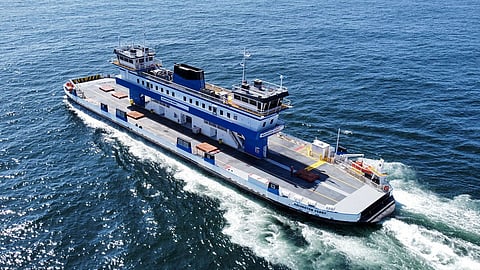VESSEL REVIEW | Esperanza "Hope" Andrade – Double-ended ferry to serve Texas’ Galveston-Port Bolivar route
The Texas Department of Transportation (TxDOT) recently welcomed a new vehicle ferry to its fleet that serves the city of Galveston and the community of Port Bolivar. The double-ended vessel has been named Esperanza “Hope” Andrade after a local businesswoman who is also the former chair of the Texas Transportation Commission as well as former Texas Secretary of State.
The ferry has a length of 293 feet (89.3 metres), a beam of 66 feet (20 metres), a draught of 16 feet (4.9 metres), and capacity for 495 passengers and either 70 passenger-driven vehicles or eight 18-wheel trailers. The propulsion system includes diesel engines and a Siemens Energy energy storage system with a lithium-ion battery.
Multiple safety features coupled with lower emissions
The TxDOT placed the new vessel into service to complement the peak demand that normally starts with the beginning of the spring break season in the United States. It will be able to cover the Galveston-Port Bolivar route in as little as 18 minutes.
“We required this vessel to be a safe and newer addition to our fleet,” Danny Perez, TxDOT Public Information Officer, told Baird Maritime. “Redundancy and safety for passengers, crew, and vessel were at the top of the list. The vessel was to be consistent with the rest of the fleet in manoeuvrability, overall operation, and – to the extent possible – equipment similarity.”
Perez added that through the use of modern technology, the vessel was designed to have a much smaller carbon footprint as the result of smaller engines and energy storage. The propulsion system components were to be a cohesive build from a proven supplier that would mesh seamlessly with the Voith Cyclodial Propeller. Perez said that while Siemens Energy and Voith have never before collaborated to provide this type of integrated system, they were able to have it work seamlessly.
“The vessel is longer and heavier than those in the rest of the fleet and utilises lithium-ion battery energy storage systems. This makes it the first double-ended ferry in the United States to be fitted with this system.”
The 1,477kWh batteries are supplemented by four Caterpillar C18 engines driving 600kW Siemens generators. The ferry will operate normally in hybrid mode with two engines and both battery rooms online. The vessel has the capability to run only on the four Caterpillar engines or for 30 minutes on battery power alone, ensuring triple redundancy for the propulsion system.
A Voith Cyclodial Propeller at each end of the vessel utilies electronic joystick controls that have triple power supplies incorporated. There are also redundant variable frequency drive Cabinets for each VSP unit.
“This arrangement makes it the safest ferry in our fleet,” said Perez. “Also, the entire vessel is powered through a Siemens Blue Drive Plus C (BDPC) system. This system provides the entire vessel with generator and/or battery power for hotel load as well as propulsion load.”
Ergonomic layouts in bridge and engine spaces
The electronics in the dual pilothouses include redundant radars, radios, searchlights with IR capability, and multiple monitors that can be set to provide any available information and data. The monitors can swivel so another crewmember can assist the captain with nighttime and fog watch operations.
An integrated automation system (IAS) by Siemens Energy provides the pilothouses, the engineer’s operating station (EOS), and multiple strategic locations with complete readouts of electrical, propulsion, engine, and support equipment readouts as well as a comprehensive alarm and notification system.
The pilothouses, the crew room, and the emergency generator compartment are all twice as large as those of the other TxDOT ferries. The front windows are from the overhead to the bridge deck to give the captain better views ahead and to the sides. The larger size of the emergency generator compartment provides easier access for inspections and maintenance.
The smaller engines in the engine room also provide easier access for inspection rounds and maintenance. Access hatches will make the change-out of large equipment safer and easier. The EOS is also spacious, ensuring comfort for the engineering crew.
“The deck equipment was outfitted to be the same as with the other vessels in the fleet,” Perez told Baird Maritime. “This enables crews to go from the oldest vessel to the newest vessel with everything being consistent. This makes changing vessels a smooth operation and increases safety for crew and passengers.”
Design work on Esperanza “Hope” Andrade was undertaken by Houston-based naval architecture firm The Shearer Group while construction took place at Gulf Island Fabrication’s Houma, Louisiana facilities. The ABS-classed ferry is the seventh to join the TxDOT’s current active fleet.


